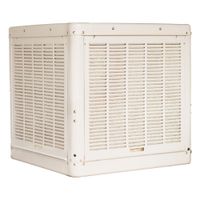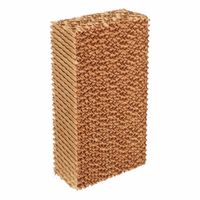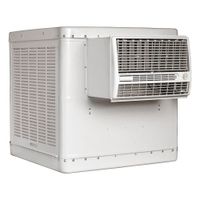Call +(254) 703 030 000 / 751 483 999 / 721 704 777
- Home
- Hvac And Refrigeration
- Air Conditioners Evaporative Coolers
- Evaporative Coolers
.....Read More
Frequently Asked Questions
How do evaporative coolers work?
Evaporative coolers, also known as swamp coolers, work by leveraging the natural process of evaporation to cool air. These devices consist of a fan, a water reservoir, and a set of pads that absorb water. Here's how they function:
1. **Water Absorption**: The cooler has pads made of materials like cellulose or aspen wood, which are designed to absorb and retain water. These pads are kept wet by a pump that continuously circulates water from the reservoir over them.
2. **Air Intake**: A fan draws warm, dry air from the outside into the cooler. As the air passes through the wet pads, it comes into contact with the water.
3. **Evaporation Process**: The heat in the air causes the water in the pads to evaporate. Evaporation is an endothermic process, meaning it absorbs heat from the surrounding environment. As the water evaporates, it removes heat from the air, thereby cooling it.
4. **Cool Air Distribution**: The now cooler and more humid air is blown into the living space by the fan. This process not only lowers the air temperature but also increases humidity, which can be beneficial in dry climates.
5. **Continuous Cycle**: The process is continuous as long as the cooler is on and there is water in the reservoir. The cycle of drawing in warm air, evaporating water, and expelling cool air repeats, maintaining a cooler indoor environment.
Evaporative coolers are most effective in hot, dry climates where humidity levels are low, as high humidity reduces the rate of evaporation and thus the cooling effect. They are energy-efficient and environmentally friendly, using less electricity than traditional air conditioning systems.
What are the benefits of using an evaporative cooler?
Evaporative coolers, also known as swamp coolers, offer several benefits, particularly in dry and arid climates. They are energy-efficient, using significantly less electricity compared to traditional air conditioning systems. This efficiency results in lower utility bills, making them a cost-effective cooling solution.
These coolers work by drawing warm air through water-saturated pads, which cools the air through evaporation. This process not only cools but also adds moisture to the air, improving indoor air quality and comfort in dry environments. The increased humidity can be beneficial for skin and respiratory health, reducing issues like dry skin and throat irritation.
Evaporative coolers are environmentally friendly, as they use water as a cooling agent instead of refrigerants, which can be harmful to the ozone layer. They also produce fewer greenhouse gas emissions due to their lower energy consumption.
Installation and maintenance of evaporative coolers are generally simpler and less expensive than traditional air conditioning systems. They have fewer mechanical components, which reduces the likelihood of breakdowns and the need for repairs.
Additionally, evaporative coolers can provide a constant supply of fresh air, as they require open windows or vents to function effectively. This continuous air exchange can help remove indoor pollutants and odors, contributing to a healthier indoor environment.
However, it's important to note that evaporative coolers are most effective in areas with low humidity. In high-humidity regions, their cooling efficiency decreases, and they may not be the best choice. Overall, for suitable climates, evaporative coolers offer an economical, eco-friendly, and health-conscious cooling option.
How much water does an evaporative cooler use?
An evaporative cooler, also known as a swamp cooler, uses water to cool air through the process of evaporation. The amount of water it uses depends on several factors, including the size of the unit, the ambient temperature, humidity levels, and the duration of operation.
On average, a residential evaporative cooler can use between 3 to 15 gallons of water per hour. Smaller units or portable coolers might use less, around 1 to 3 gallons per hour, while larger, more powerful units can consume up to 20 gallons per hour. The water usage is directly related to the cooling capacity and the efficiency of the cooler.
In dry, hot climates where evaporative coolers are most effective, the water consumption might be on the higher end due to the increased evaporation rate. Conversely, in more humid conditions, the cooler might use less water as the evaporation process is less efficient.
The water usage can also be influenced by the specific design and technology of the cooler. Some modern evaporative coolers are designed to be more water-efficient, incorporating features like water recirculation systems that minimize waste.
To calculate the total water usage, consider the number of hours the cooler operates daily. For instance, if a cooler uses 10 gallons per hour and runs for 8 hours a day, it would consume 80 gallons of water daily.
Overall, while evaporative coolers are generally more energy-efficient than traditional air conditioners, their water consumption is a crucial factor to consider, especially in areas where water conservation is a concern. Regular maintenance, such as checking for leaks and ensuring efficient operation, can help optimize water usage.
Can evaporative coolers be used in humid climates?
Evaporative coolers, also known as swamp coolers, are generally less effective in humid climates. These devices work by evaporating water to cool the air, which is most efficient when the air is dry. In humid conditions, the air is already saturated with moisture, reducing the rate of evaporation and, consequently, the cooling effect.
In dry climates, evaporative coolers can significantly lower temperatures by adding moisture to the air, which then absorbs heat as it evaporates. However, in humid environments, the air's high moisture content limits the amount of additional water it can absorb, diminishing the cooler's ability to lower temperatures effectively.
Moreover, using evaporative coolers in humid climates can increase indoor humidity levels, potentially leading to discomfort and issues like mold growth. High humidity can also affect the performance of the cooler itself, as the cooling pads may not dry out properly, leading to potential maintenance issues.
While evaporative coolers are energy-efficient and cost-effective in dry regions, in humid areas, traditional air conditioning systems are typically more effective. These systems remove moisture from the air while cooling, providing a more comfortable indoor environment.
In summary, while technically possible, using evaporative coolers in humid climates is not recommended due to their reduced efficiency and potential to increase indoor humidity.
How do you maintain an evaporative cooler?
To maintain an evaporative cooler, follow these steps:
1. **Regular Cleaning**: Clean the cooler regularly to prevent mold and mildew. Turn off and unplug the unit. Remove the panels and clean the water tank, fan blades, and interior with a mild detergent and water. Rinse thoroughly.
2. **Check and Replace Pads**: Inspect the cooling pads for wear and mineral deposits. Replace them if they are damaged or clogged. Typically, pads should be replaced every 1-3 years, depending on water quality and usage.
3. **Water Management**: Ensure the water tank is clean and free of debris. Use fresh water and consider adding a water treatment solution to prevent mineral buildup. Check the water pump and ensure it is functioning properly.
4. **Inspect and Clean the Pump**: Regularly check the pump for clogs or damage. Clean the pump and its filter to ensure efficient water circulation.
5. **Examine the Motor and Fan**: Inspect the motor and fan for dust and debris. Clean them to ensure smooth operation. Lubricate the motor bearings if necessary, following the manufacturer's instructions.
6. **Check the Float Valve**: Ensure the float valve is working correctly to maintain the proper water level. Adjust or replace it if it is malfunctioning.
7. **Inspect Electrical Components**: Check all electrical connections and wiring for wear or damage. Ensure all connections are secure and replace any damaged wires.
8. **Seasonal Maintenance**: Before storing the cooler for the winter, drain the water tank, clean the unit thoroughly, and cover it to protect against dust and debris. In spring, perform a full inspection and cleaning before use.
9. **Regular Monitoring**: During operation, monitor the cooler for unusual noises or performance issues and address them promptly.
By following these steps, you can ensure your evaporative cooler operates efficiently and has a longer lifespan.
What is the difference between evaporative coolers and air conditioners?
Evaporative coolers and air conditioners are both used for cooling indoor spaces, but they operate on different principles and are suited for different environments.
Evaporative coolers, also known as swamp coolers, use the natural process of evaporation to cool air. They draw warm outside air through water-saturated pads, causing the water to evaporate and cool the air. This cooled air is then circulated into the indoor space. Evaporative coolers are most effective in hot, dry climates where humidity is low, as they add moisture to the air. They are energy-efficient, consuming less electricity than air conditioners, and are environmentally friendly since they use water as a cooling agent instead of refrigerants.
Air conditioners, on the other hand, use a refrigeration cycle to cool air. They draw warm indoor air over a set of coils containing a refrigerant, which absorbs the heat and cools the air. The cooled air is then recirculated into the room, while the absorbed heat is expelled outside. Air conditioners are effective in a wide range of climates, including humid environments, as they can dehumidify the air. However, they typically consume more energy than evaporative coolers and use refrigerants, which can have environmental impacts if not managed properly.
In summary, evaporative coolers are ideal for dry climates, are energy-efficient, and add humidity to the air, while air conditioners are versatile for various climates, provide dehumidification, and generally offer more precise temperature control but at a higher energy cost.
How effective are evaporative coolers in cooling large spaces?
Evaporative coolers, also known as swamp coolers, are effective in cooling large spaces under specific conditions. They work by drawing warm air through water-saturated pads, causing the water to evaporate and cool the air. This process is most effective in dry, arid climates where humidity levels are low, as the evaporation rate is higher, leading to more significant cooling.
In large spaces, evaporative coolers can be quite effective if the environment is suitable. They are energy-efficient, consuming less electricity than traditional air conditioning systems, which makes them cost-effective for cooling expansive areas. Additionally, they provide a constant flow of fresh air, improving indoor air quality and reducing the need for additional ventilation systems.
However, their effectiveness diminishes in humid climates, as the air's capacity to absorb moisture is limited, resulting in less cooling. In such environments, the cooler may not achieve the desired temperature reduction, and the increased humidity can lead to discomfort and potential mold growth.
For optimal performance in large spaces, it's crucial to ensure proper sizing and placement of the evaporative cooler. The unit should be capable of delivering sufficient airflow to cover the entire area, and strategic placement can enhance air circulation. Regular maintenance, such as cleaning the pads and ensuring adequate water supply, is essential to maintain efficiency.
In summary, evaporative coolers can be highly effective in cooling large spaces in dry climates, offering energy efficiency and improved air quality. However, their performance is limited in humid conditions, and careful consideration of the environment and maintenance is necessary to maximize their cooling potential.




